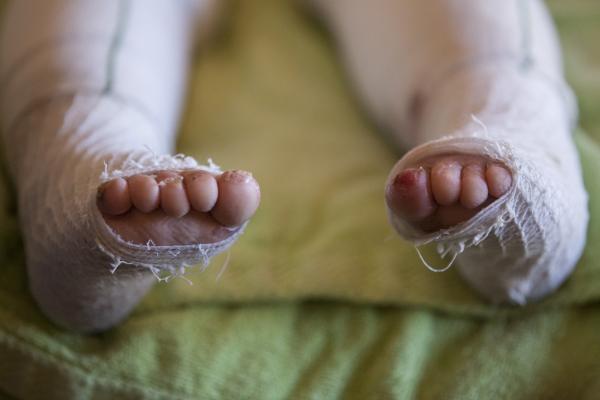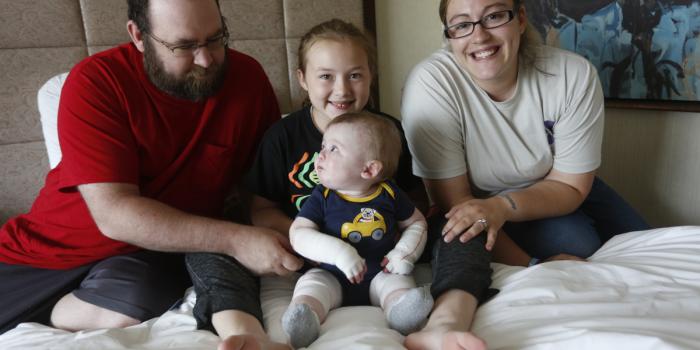*CLICK HERE TO DOWNLOAD A PDF VERSION OF THIS PAGE.
The primary goal of wound care products for Epidermolysis Bullosa (EB) is to promote wound healing. They also provide comfort and prevent pain and re-injury.
These products should be easy to apply and cost effective as well. As a result, selection of wound care products is often based on personal preferences.
It is important to note this is just a small list of the various wound care products helpful to some people affected with EB. There is no one product that works for every person.

EB wound care products vary widely and may be used for different purposes. Your physician or nurse will help you decide which dressings to use for your wounds. Please make sure to review the proper way to use your dressings with your medical team.
Some of the products listed below may be obtained through a wound care supplier or distributor. If you do not have one yet, you may wish to contact one of the EB experienced distributors.
Dressing Basics

After lancing and gently draining EB blisters, ointments and dressings are typically applied. The term dressings may be used interchangeably with bandages. In addition to cleansers and topical products, there may be two or three layers of dressings applied. The first or primary layer is non-adherent, and the products used are primarily based on individual tolerance and family preference. The second layer stabilizes the primary layer and provides padding and protection. The third layer is used to maintain the dressing in place. It is usually somewhat elastic in nature.
EB Product Recommendations
Cleansers and Topical Products
Some cleansers used successfully in EB include:
- Cetaphil mild non-soap cleanser
- Dove mild soap
It is important to use gentle cleansers and wash the wounds and skin routinely.
These are some of the non-medicated topicals that when used alone, or on a dressing, help maintain a moist environment on wound bed and helps to prevent sticking to the wound.
- A&D (Manufacturer: Schering-Plough HealthCare Products, Inc.)
- Aquaphor (Manufacturer: Beirsdorf)
- Curefini (Manufacturer: Rev Pharma Corp.)
- Emu-oil (Manufacturer: various)
- Unrefined coconut oil (Manufacturer: various)
- White petroleum (Manufacturer: various)
Over the counter (OTC) antibiotic ointments:
- Bacitracin (Manufacturer: various)
- Polysporin (Manufacturer: various)
Apply topical antibiotics to lesions: Mild, over-the-counter antibiotics (Polysporin, Bacitracin) are effective in preventing infection and may be rotated every month or two to discourage bacterial resistance.
It is important to note that some data suggests that white petrolatum is a better antibacterial agent than those listed above and it does not cause allergic contact dermatitis. There are EB providers who advocate its use for that reason.
Prescription antibiotic ointments:
- Mupirocin (Manufacturer: Centany, Bactroban)
Mupirocin should be used only when infection is present. (Signs of infection include increased redness, swelling, pain and warmth).
Prolonged use of antibiotics has been associated with the development of resistant Staph infections.
MediHoney (Manufacturer: DermaSciences)
This type of product can be helpful in cleaning up draining wounds. The ointment can be applied to the dressings already used by the family.
*It is very important to remember that you must use medical grade honey and that honey from your local grocery store is not to be used under any circumstances.
- Aquacel AG (Manufacturer: ConvaTec)
- Acticoat (Manufacturer: Smith&Nephew)
- Mepilex AG (Manufacturer: Molnlycke)
- Mepilex Transfer AG (Manufacturer: Molnlycke)
- Silvasorb (Manufacturer: Medline)
- UrgoTul Ag/Silver Contact Layer (Manufacturer: Urgo)
Different modes of silver delivery can lead to varying rates of absorption. There are many unanswered questions about the safety of long-term use of silver products and there is not consensus among EB providers regarding its use in EB. With improper use there have been a few documented cases in the laboratory of bacteria becoming resistant to silver.
Until clinical trials are conducted that prove these products are safe to use on a regular long-term basis, individuals should use the products cautiously and for limited periods of time.
- Xeroform Kendall Health Care contains a medication called Bismuthtribromophenate.
- AMD Kendall Health
First Layer Dressings
The first or primary layer is non-adherent and the products used are primarily based on individual tolerance and family preference.
These dressings are made up of a single layer, non-adherent woven mesh like material:
- Adaptic Touch (Manufacturer: Sysagenix)
- Conformant 2 (Manufacturer: Smith & Nephew)
- Duoderm (Manufacturer: ConvaTec)
- Mepitel (Manufacturer: Molnlycke)
- N-Terface (Manufacturer: Winfield Laboratories, Inc.)
- UrgoTul Contact Layer (Manufacturer: Urgo)
One of the benefits of using contact layers is the fact that they can stay on the wound bed for several days without disturbing the newly healed skin. Depending on the condition of the wound, the surrounding skin and the presence of infection, the physician may modify the frequency of dressing changes.
Hydrogels may be in the form of either a gel, impregnated into gauze or in the form of a hydrated sheet dressing:
- KerraLite Cool (Manufacturer: Crawford Health Care)
- Vigilon (Manufacturer: Bard)
Basically made up of glycerin or water, they hydrate wounds providing a moist environment enhancing re-epithelialization. These dressings may be cooled in the refrigerator to provide a soothing effect on painful wounds.
Hydrogels may be helpful as primary dressings to a varied number of wounds. They are not usually recommended for wounds with heavy exudate. Please note in some instances hydrogels may dehydrate if not covered appropriately. If this happens, the dressing will need to be moistened for removal.
Note, these dressings may also be used as secondary (second layer) dressings as well.
Second Layer Dressings
The bandages listed below may be placed over the initial first layer (which is a contact layer or hydrogel, as described above) or may go directly on the wound area if a traditional primary layer is not being used. Different types include:
The gauze dressings listed below are impregnated with Vaseline, Aquaphor or Zinc Oxide. Some examples of impregnated gauze include:
- Vaseline Gauze (Manufacturers: Covidien)
- Viscopaste Zinc Oxide Paste Gauze (Manufacturers: Smith & Nephew)
Adding additional ointment will help prevent the gauze from drying out and hardening.
Provides a non-stick covering for the wounds. These may also be used with or without a first/contact layer:
- Telfa (Manufacturers: Covidien, Medline)
- Non-Adhesive Pads (Manufacturers: Johnson&Johnson, Medline)
These dressings are non-adherent and absorbent
- Allevyn Non-Adhesive (Manufacturer: Smith & Nephew)
- Mepilex (Manufacturer: Molnlycke)
- Mepilex Transfer (Manufacturer: Molnlycke)
- Mepilex Lite (Manufacturer: Molnlycke)
- Mepilex Border (Manufacturer: Molnlycke)
- Mepilex Border Lite (Manufacturer: Molnlycke)
- PolyMem (Manufacturer: Polymem Ferris Mfg Corp)
- UrgoTulAbsorb, Border Foam (Manufacturer: Urgo)
- UrgoTulAbsorb, Non-Border Foam (Manufacturer: Urgo)
Most foams provide insulation and a moist environment. Foam dressings are used on wounds with light to heavy amounts of drainage. Please keep in mind if the dressing becomes saturated with drainage, it could irritate the surrounding skin.
Foams can also be used for heavier draining, non-infected wounds and can be used over a contact layer. Depending on the condition of the wound, the surrounding skin and the presence of infection, the physician may modify the frequency of dressing changes.
These dressings provide a non-shearing, non-adherent, absorbent environment that allows for the wicking away of drainage:
- Exu-dry (Manufacturer: Smith & Nephew)
These dressings can be utilized on wounds with mild or heavy drainage and can be used to provide a cushion/padding for areas of the skin that can come into contact with pressure such as crib, playpen, high chair and play areas. Special use: some hospitals will use a large sheet of Exu-dry under a newborn.
When applied to a wound it creates a gel after coming into contact with wound exudate. This provides a moist environment and helps reduce damage of newly forming tissue upon removal and should only be used on moderately to heavily draining wounds.
- Aquacel (Manufacturer: ConvaTec)
These dressings are not indicated for dry (non-draining) wounds. The gel can be rinsed or soaked away with saline, allowing removal of the dressing without re-traumatizing the wound bed and minimizing pain. Depending on the condition of the wound, the surrounding skin and the presence of infection, the physician may modify the frequency of dressing changes.
Third Layer Dressings
The third layer dressing is used to maintain the other dressing(s) in place. It is usually somewhat elastic in nature.
Cotton mesh interwoven material.
- Rolled Gauze (Manufacturer: various)
- Kerlix (Manufacturer: Covidien)
- Gauze Pads (Manufacturer: various)
This net dressing helps hold the primary and secondary layers of bandages in place. They are packaged as a roll and are cut to length based on the bandaged area. They are washable and can be used more than once. There are many options:
- Spandage (Manufacturer: Medline)
- Surgilast (Manufacturer: DermaSciences)
- Tubifast 2-way Stretch (Manufacturer: Molnlycke)
Similar in look to a roller bandage, these options come in many colors and the layers will adhere to itself, which helps it stay in place.
- Coban (Manufacturer: 3M)
- Coflex (Manufacturer: Andover)
Other
While it is better to avoid having adhesives and tape applied to EB skin, accidents happen. These are some suggestions of products that can help remove things that stick to skin and wounds.
- Trio Elite Sting-Free Adhesive Remover
- Sensi-Care Adhesive Remover Wipes (Manufacturer: ConvaTec)
- Sensi-Care Adhesive Remover Spray (Manufacturer: ConvaTec)
Used to cover and protect IV Sites.
- IV Clear (Manufacturer: Covalon)
Sterile sponges designed for low-friction cleansing:
- Optipore Sponge (Manufacturer: ConvaTec)
Wound Care for Non-Healing Wounds
For non-healing wounds, your medical provider may decide to use a specialized product to help close the wounds. With the advancement of science, there are many useful wound care products that are either collagen based or even live cells. Advanced wound care products should only be used in those individuals with a chronic wound that will not heal with simple good wound care. Your healthcare provider, or a specialist in wound care, can help you determine if one of these advanced wound care products are right for a non-healing wound and review your options with you.
*Please note that all medical information given by debra of America is for informational purposes only. Our information is not intended to substitute the care and guidance given by a qualified physician. All regimens of care should be discussed with the patient's doctor. Always check with your physician prior to starting any medications or treatment regimens.






